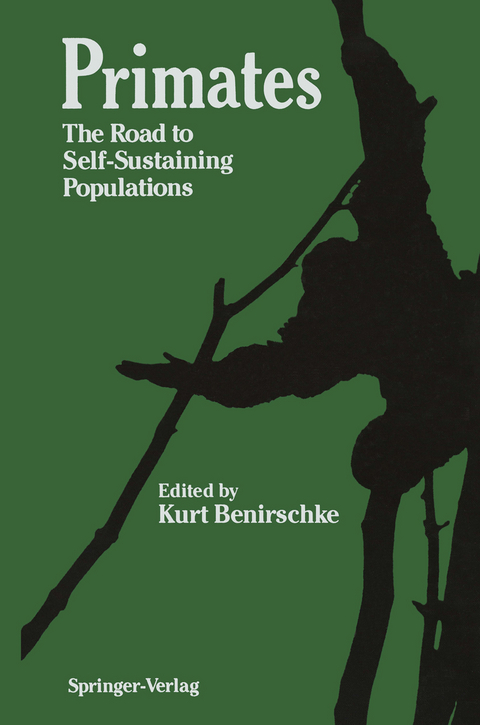
Primates
Springer-Verlag New York Inc.
978-1-4612-9360-6 (ISBN)
This conference represents the first time in my life when I felt it was a misfor tune, rather than a major cause of my happiness, that I do conservation work in New Guinea. Yes, it is true that New Guinea is a fascinating microcosm, it has fascinating birds and people, and it has large expanses of undisturbed rainforest. In the course of my work there, helping the Indonesian government and World Wildlife Fund set up a comprehensive national park system, I have been able to study animals in areas without any human population. But New Guinea has one serious drawback: it has no primates, except for humans. Thus, I come to this conference on primate conservation as an underprivileged and emotionally deprived observer, rather than as an involved participant. Nevertheless, it is easy for anyone to become interested in primate conserva tion. The public cares about primates. More specifically, to state things more realistically, many people care some of the time about some primates. Primates are rivaled only by birds, pandas, and the big cats in their public appeal. For some other groups of animals, the best we can say is that few people care about them, infrequently. For most groups of animals, no one cares about them, ever.
1. Primate Ethics.- 2. The Role of Captive Populations in Global Conservation.- 3. African Primate Conservation: General Needs and Specific Priorities.- 4. Gorilla Conservation: Anatomy of a Campaign.- 5. Captive Chimpanzee Populations—Past, Present, and Future.- 6. Responses of Rainforest Primates to Selective Logging in Kibale Forest, Uganda: A Summary Report.- 7. Lemur Survival.- 8. The Conservation Status of Nonhuman Primates in Indonesia.- 9. Southeast Asian Primates.- 10. Conservation of Orangutans: A Status Report, 1985.- 11. The Natural Breeding Strategy of Gibbons (Hylobates lar): Are We Managing the Captive Population by Design or by Default?.- 12. The Primates of India: Status, Trends, and Conservation.- 13. Increased Home Range for a Self-Sustaining Free-Ranging Rhesus Population at Tughlaqabad, India.- 14. Balancing the Wild/Captive Equation—The Case of the Barbary Macaque (Macaca sylvanus L.).- 15. Primate Status and Conservation in China.- 16. Primate Conservation Priorities in the Neotropical Region.- 17. Ecological Background and Conservation Priorities for Woolly Spider Monkeys (Brachyteles arachnoides).- 18. Successes and Failures of Captive Breeding.- 19. History of Geoffroy’s Tamarins, Saguinus geoffroyi, at Lincoln Park Zoological Gardens; 1974–1985.- 20. The Management of Prosimians in Captivity for Conservation and for Research.- 21. Corral Breeding of Nonhuman Primates.- 22. Environments for Captive Propagation of Primates: Interaction of Social and Physical Factors.- 23. Behavior Requirements for Self-Sustaining Primate Populations—Some Theoretical Considerations and a Closer Look at Social Behavior.- 24. Early Socialization.- 25. Behavioral Aspects of Successful Reproduction in Primates.- 26. Conflict Resolution in Monkeys and Apes.-27. Resocialization of Asocial Chimpanzees.- 28. Primate Mating Systems and Their Consequences for Captive Management.- 29. The Interbirth Interval in Primates: Effects of Pregnancy and Nursing.- 30. Embryonic Loss in Primates in Relation to In Vitro Fertilization and Embryo Transfer.- 31. Artificial Acceleration of Reproduction.- 32. Collection, Assessment, and Storage of Sperm.- 33. Artificial Insemination of Nonhuman Primates.- 34. Primate Models for Fertilization and Early Embryogenesis.- 35. Housing and Furniture.- 36. The Howletts Gorilla Bands.- 37. Using Outside Areas for Tropical Primates in the Northern Hemisphere: Callitrichidae, Saimiri, and Gorilla.- 38. Evaluating the Environments of Captive Nonhuman Primates.- 39. Environmental Engineering for Primates.- 40. Research Faculity Breeding.- 41. Research Uses and Projections of Nonhuman Primates as Research Subjects.- 42. Approaches to Determining Colony Infections and Improving Colony Health.- 43. Bacterial Infections of Nonhuman Primates.- 44. Mycotic Infections in Nonhuman Primates.- 45. The Pathoparasitology of Nonhuman Primates: A Review.- 46. Overview of Simian Viruses and Recognized Virus Diseases and Laboratory Support for the Diagnosis of Viral Infections.- 47. Virus-Associated Neoplastic and Immunosuppressive Diseases of Nonhuman Primates.- 48. Viral Diseases of Neonatal and Infant Nonhuman Primates.- 49. Acute Myocarditis in Golden Monkeys.- 50. Rearing and Intensive Care of Neonatal and Infant Nonhuman Primates.- 51. Prenatal and Neonatal Pathology of Captive Nonhuman Primates.- 52. The Effect of Perinatal and Juvenile Mortality on Colony-Born Production at the New England Regional Primate Research Center.- 53. Neoplasms and Proliferative Disorders in Nonhuman Primates.- 54. Scaling and Anesthesiafor Primates.- 55. Nutrition of Primates in Captivity.- 56. The Chinese Golden Monkey—Husbandry and Reproduction.- 57. Captive Status and Genetic Considerations.- 58. Incidence and Consequences of Inbreeding in Three Captive Groups of Rhesus Macaques (Macaca mulatta).- 59. Hereditary Conditions of Nonhuman Primates.- 60. Chromosomal and Molecular Characterization of the Primates: Its Relevance in the Sustaining of Primate Populations.- 61. Considering Subspecies in the Captive Management of Ateles.- 62. Blood Groups of Apes and Monkeys.- 63. The Mind of the Gorilla: Conversation and Conservation.- 64. Translocation of Primates.- 65. Conservation Program for the Golden Lion Tamarin: Captive Research and Management, Ecological Studies, Educational Strategies, and Reintroduction.- 66. Before We Pilot the Ark?.- 67. Who Will Pilot the Ark?.- 68. The Road to the Ark from the Zoo’s Perspective.- 69. Who Will Save the Children?.- 70. The Importance of an Interdisciplinary Approach: Getting the Conservation Act Together.- 71. Recommendations of Workshops.- A. Strategies for the Extremely Endangered Primates.- B. Artificial Breeding.- C. Virus Diseases.- 72. Strategies for the Conservation of Highly Endangered Primates.- 73. Research Needs in Captive Primate Colonies.- 74. Researchable Problems in the Natural Realm.
| Reihe/Serie | Proceedings in Life Sciences |
|---|---|
| Vorwort | Jared Diamond |
| Zusatzinfo | XXIII, 1044 p. |
| Verlagsort | New York, NY |
| Sprache | englisch |
| Maße | 155 x 235 mm |
| Themenwelt | Naturwissenschaften ► Biologie ► Ökologie / Naturschutz |
| Naturwissenschaften ► Biologie ► Zellbiologie | |
| Naturwissenschaften ► Biologie ► Zoologie | |
| Weitere Fachgebiete ► Land- / Forstwirtschaft / Fischerei | |
| ISBN-10 | 1-4612-9360-X / 146129360X |
| ISBN-13 | 978-1-4612-9360-6 / 9781461293606 |
| Zustand | Neuware |
| Haben Sie eine Frage zum Produkt? |
aus dem Bereich


